page 225 BMW 335I CONVERTIBLE 2009 E93 Owner's Manual
[x] Cancel search | Manufacturer: BMW, Model Year: 2009, Model line: 335I CONVERTIBLE, Model: BMW 335I CONVERTIBLE 2009 E93Pages: 260, PDF Size: 7.95 MB
Page 197 of 260
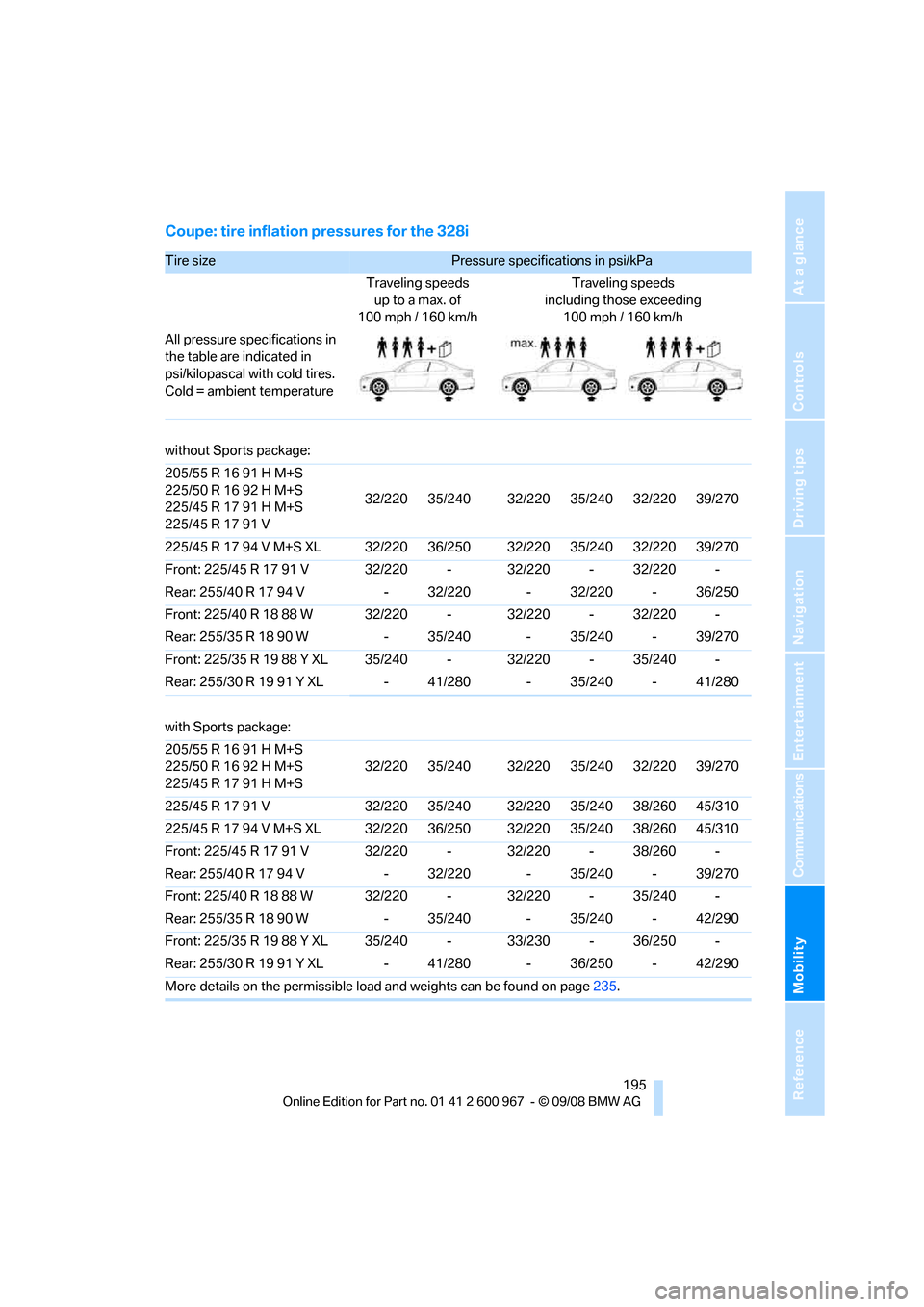
Mobility
195Reference
At a glance
Controls
Driving tips
Communications
Navigation
Entertainment
Coupe: tire inflation pressures for the 328i
Tire size Pressure specifications in psi/kPa
Traveling speeds
up to a max. of
100 mph / 160 km/hTraveling speeds
including those exceeding
100 mph / 160 km/h
All pressure specifications in
the table are indicated in
psi/kilopascal with cold tires.
Cold = ambient temperature
without Sports package:
205/55 R 16 91 H M+S
225/50 R 16 92 H M+S
225/45 R 17 91 H M+S
225/45 R 17 91 V32/220 35/240 32/220 35/240 32/220 39/270
225/45 R 17 94 V M+S XL 32/220 36/250 32/220 35/240 32/220 39/270
Front: 225/45 R 17 91 V 32/220 - 32/220 - 32/220 -
Rear: 255/40 R 17 94 V - 32/220 - 32/220 - 36/250
Front: 225/40 R 18 88 W 32/220 - 32/220 - 32/220 -
Rear: 255/35 R 18 90 W - 35/240 - 35/240 - 39/270
Front: 225/35 R 19 88 Y XL 35/240 - 32/220 - 35/240 -
Rear: 255/30 R 19 91 Y XL - 41/280 - 35/240 - 41/280
with Sports package:
205/55 R 16 91 H M+S
225/50 R 16 92 H M+S
225/45 R 17 91 H M+S32/220 35/240 32/220 35/240 32/220 39/270
225/45 R 17 91 V 32/220 35/240 32/220 35/240 38/260 45/310
225/45 R 17 94 V M+S XL 32/220 36/250 32/220 35/240 38/260 45/310
Front: 225/45 R 17 91 V 32/220 - 32/220 - 38/260 -
Rear: 255/40 R 17 94 V - 32/220 - 35/240 - 39/270
Front: 225/40 R 18 88 W 32/220 - 32/220 - 35/240 -
Rear: 255/35 R 18 90 W - 35/240 - 35/240 - 42/290
Front: 225/35 R 19 88 Y XL 35/240 - 33/230 - 36/250 -
Rear: 255/30 R 19 91 Y XL - 41/280 - 36/250 - 42/290
More details on the permissible load and weights can be found on page235.
Page 198 of 260
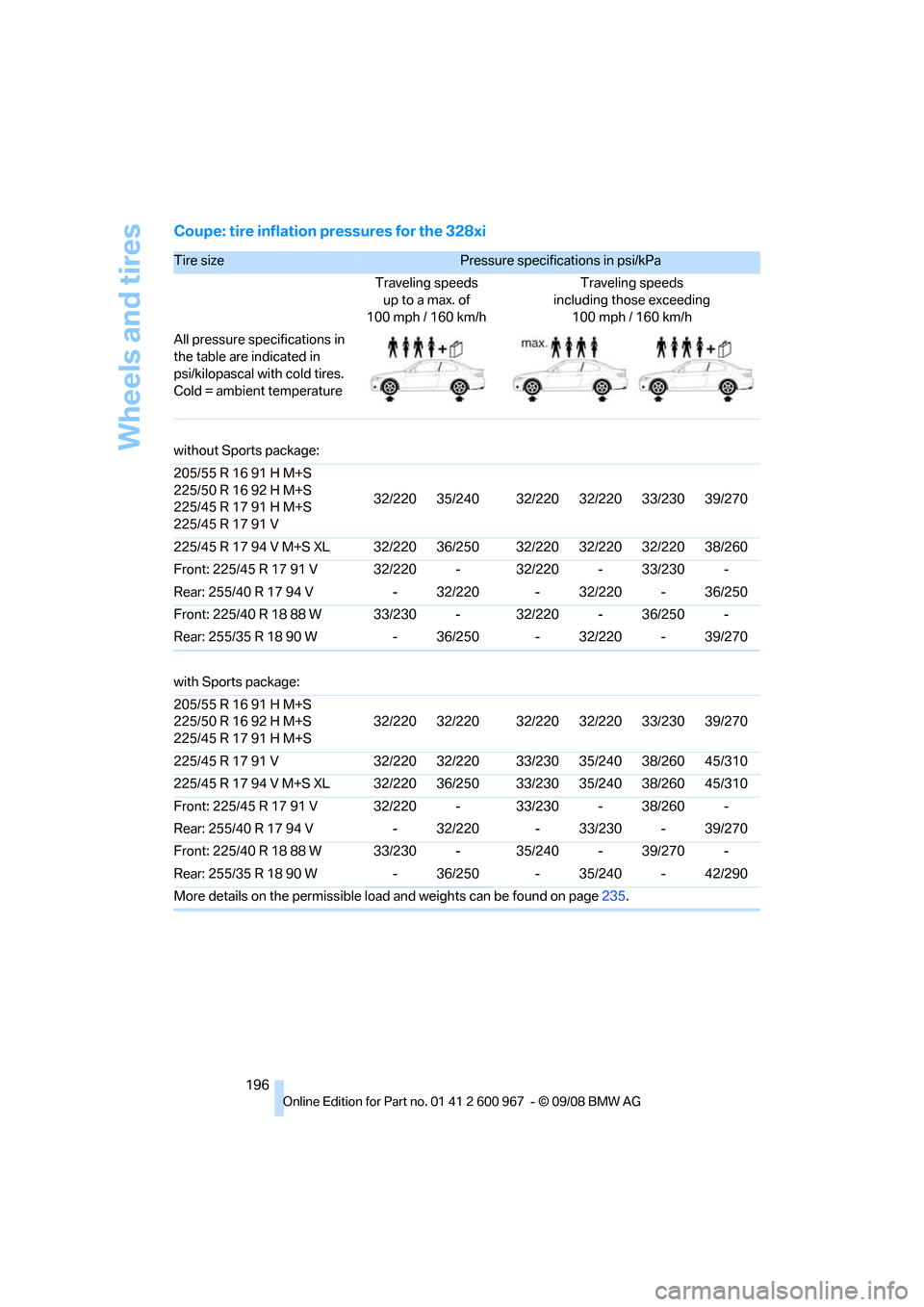
Wheels and tires
196
Coupe: tire inflation pressures for the 328xi
Tire size Pressure specifications in psi/kPa
Traveling speeds
up to a max. of
100 mph / 160 km/hTraveling speeds
including those exceeding
100 mph / 160 km/h
All pressure specifications in
the table are indicated in
psi/kilopascal with cold tires.
Cold = ambient temperature
without Sports package:
205/55 R 16 91 H M+S
225/50 R 16 92 H M+S
225/45 R 17 91 H M+S
225/45 R 17 91 V32/220 35/240 32/220 32/220 33/230 39/270
225/45 R 17 94 V M+S XL 32/220 36/250 32/220 32/220 32/220 38/260
Front: 225/45 R 17 91 V 32/220 - 32/220 - 33/230 -
Rear: 255/40 R 17 94 V - 32/220 - 32/220 - 36/250
Front: 225/40 R 18 88 W 33/230 - 32/220 - 36/250 -
Rear: 255/35 R 18 90 W - 36/250 - 32/220 - 39/270
with Sports package:
205/55 R 16 91 H M+S
225/50 R 16 92 H M+S
225/45 R 17 91 H M+S32/220 32/220 32/220 32/220 33/230 39/270
225/45 R 17 91 V 32/220 32/220 33/230 35/240 38/260 45/310
225/45 R 17 94 V M+S XL 32/220 36/250 33/230 35/240 38/260 45/310
Front: 225/45 R 17 91 V 32/220 - 33/230 - 38/260 -
Rear: 255/40 R 17 94 V - 32/220 - 33/230 - 39/270
Front: 225/40 R 18 88 W 33/230 - 35/240 - 39/270 -
Rear: 255/35 R 18 90 W - 36/250 - 35/240 - 42/290
More details on the permissible load and weights can be found on page235.
Page 199 of 260
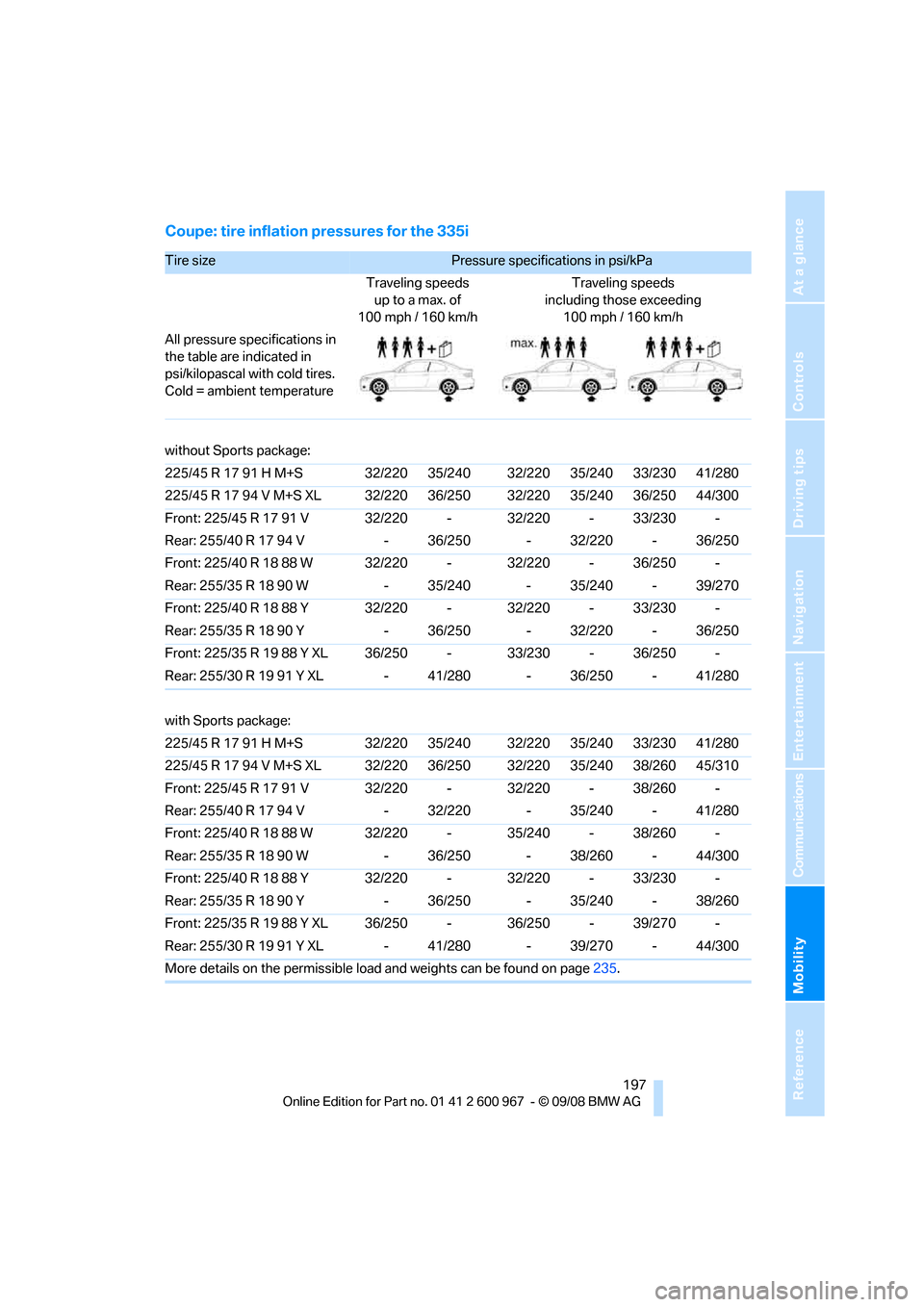
Mobility
197Reference
At a glance
Controls
Driving tips
Communications
Navigation
Entertainment
Coupe: tire inflation pressures for the 335i
Tire size Pressure specifications in psi/kPa
Traveling speeds
up to a max. of
100 mph / 160 km/hTraveling speeds
including those exceeding
100 mph / 160 km/h
All pressure specifications in
the table are indicated in
psi/kilopascal with cold tires.
Cold = ambient temperature
without Sports package:
225/45 R 17 91 H M+S 32/220 35/240 32/220 35/240 33/230 41/280
225/45 R 17 94 V M+S XL 32/220 36/250 32/220 35/240 36/250 44/300
Front: 225/45 R 17 91 V 32/220 - 32/220 - 33/230 -
Rear: 255/40 R 17 94 V - 36/250 - 32/220 - 36/250
Front: 225/40 R 18 88 W 32/220 - 32/220 - 36/250 -
Rear: 255/35 R 18 90 W - 35/240 - 35/240 - 39/270
Front: 225/40 R 18 88 Y 32/220 - 32/220 - 33/230 -
Rear: 255/35 R 18 90 Y - 36/250 - 32/220 - 36/250
Front: 225/35 R 19 88 Y XL 36/250 - 33/230 - 36/250 -
Rear: 255/30 R 19 91 Y XL - 41/280 - 36/250 - 41/280
with Sports package:
225/45 R 17 91 H M+S 32/220 35/240 32/220 35/240 33/230 41/280
225/45 R 17 94 V M+S XL 32/220 36/250 32/220 35/240 38/260 45/310
Front: 225/45 R 17 91 V 32/220 - 32/220 - 38/260 -
Rear: 255/40 R 17 94 V - 32/220 - 35/240 - 41/280
Front: 225/40 R 18 88 W 32/220 - 35/240 - 38/260 -
Rear: 255/35 R 18 90 W - 36/250 - 38/260 - 44/300
Front: 225/40 R 18 88 Y 32/220 - 32/220 - 33/230 -
Rear: 255/35 R 18 90 Y - 36/250 - 35/240 - 38/260
Front: 225/35 R 19 88 Y XL 36/250 - 36/250 - 39/270 -
Rear: 255/30 R 19 91 Y XL - 41/280 - 39/270 - 44/300
More details on the permissible load and weights can be found on page235.
Page 200 of 260
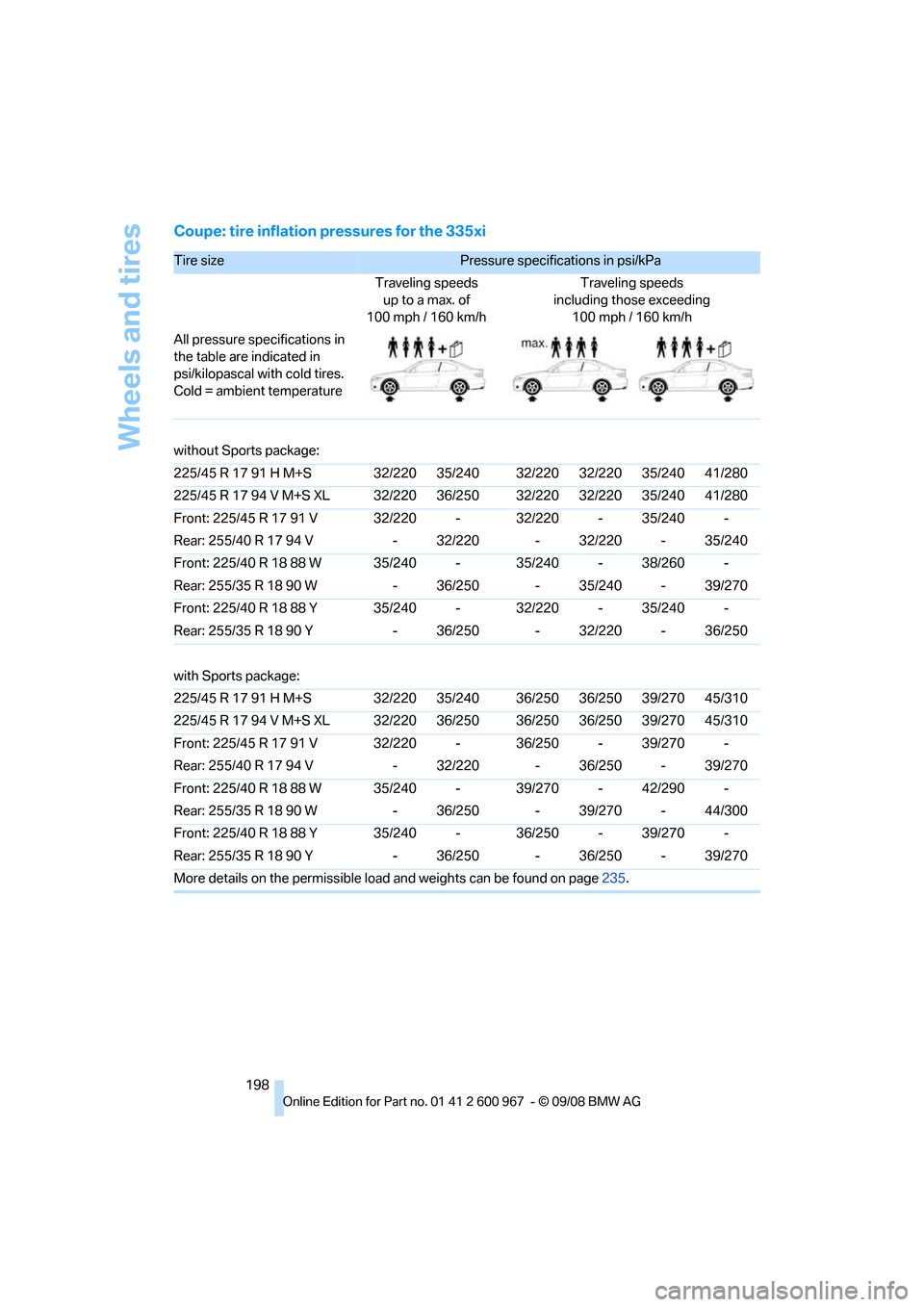
Wheels and tires
198
Coupe: tire inflation pressures for the 335xi
Tire size Pressure specifications in psi/kPa
Traveling speeds
up to a max. of
100 mph / 160 km/hTraveling speeds
including those exceeding
100 mph / 160 km/h
All pressure specifications in
the table are indicated in
psi/kilopascal with cold tires.
Cold = ambient temperature
without Sports package:
225/45 R 17 91 H M+S 32/220 35/240 32/220 32/220 35/240 41/280
225/45 R 17 94 V M+S XL 32/220 36/250 32/220 32/220 35/240 41/280
Front: 225/45 R 17 91 V 32/220 - 32/220 - 35/240 -
Rear: 255/40 R 17 94 V - 32/220 - 32/220 - 35/240
Front: 225/40 R 18 88 W 35/240 - 35/240 - 38/260 -
Rear: 255/35 R 18 90 W - 36/250 - 35/240 - 39/270
Front: 225/40 R 18 88 Y 35/240 - 32/220 - 35/240 -
Rear: 255/35 R 18 90 Y - 36/250 - 32/220 - 36/250
with Sports package:
225/45 R 17 91 H M+S 32/220 35/240 36/250 36/250 39/270 45/310
225/45 R 17 94 V M+S XL 32/220 36/250 36/250 36/250 39/270 45/310
Front: 225/45 R 17 91 V 32/220 - 36/250 - 39/270 -
Rear: 255/40 R 17 94 V - 32/220 - 36/250 - 39/270
Front: 225/40 R 18 88 W 35/240 - 39/270 - 42/290 -
Rear: 255/35 R 18 90 W - 36/250 - 39/270 - 44/300
Front: 225/40 R 18 88 Y 35/240 - 36/250 - 39/270 -
Rear: 255/35 R 18 90 Y - 36/250 - 36/250 - 39/270
More details on the permissible load and weights can be found on page235.
Page 202 of 260
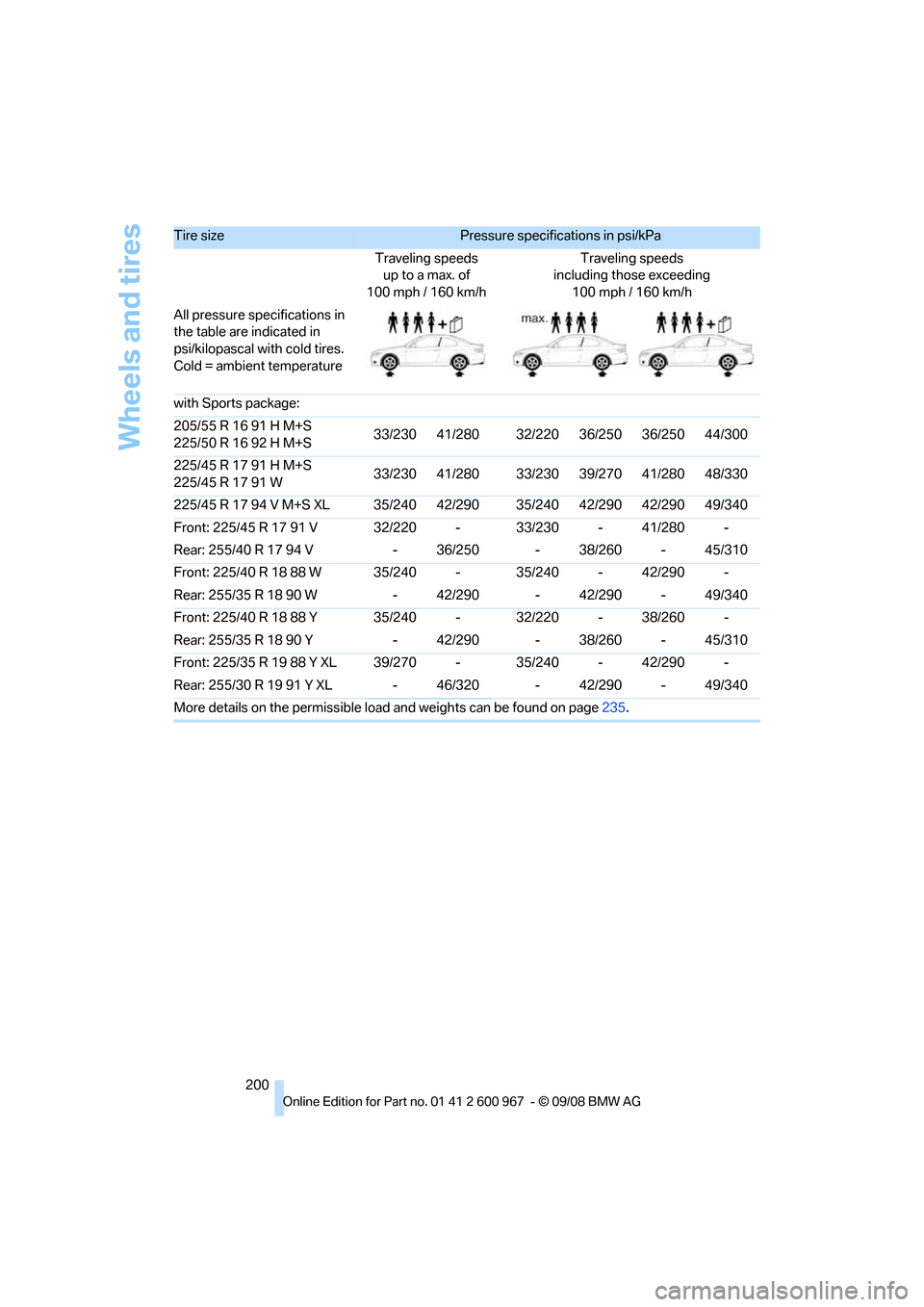
Wheels and tires
200 with Sports package:
205/55 R 16 91 H M+S
225/50 R 16 92 H M+S33/230 41/280 32/220 36/250 36/250 44/300
225/45 R 17 91 H M+S
225/45 R 17 91 W33/230 41/280 33/230 39/270 41/280 48/330
225/45 R 17 94 V M+S XL 35/240 42/290 35/240 42/290 42/290 49/340
Front: 225/45 R 17 91 V 32/220 - 33/230 - 41/280 -
Rear: 255/40 R 17 94 V - 36/250 - 38/260 - 45/310
Front: 225/40 R 18 88 W 35/240 - 35/240 - 42/290 -
Rear: 255/35 R 18 90 W - 42/290 - 42/290 - 49/340
Front: 225/40 R 18 88 Y 35/240 - 32/220 - 38/260 -
Rear: 255/35 R 18 90 Y - 42/290 - 38/260 - 45/310
Front: 225/35 R 19 88 Y XL 39/270 - 35/240 - 42/290 -
Rear: 255/30 R 19 91 Y XL - 46/320 - 42/290 - 49/340
More details on the permissible load and weights can be found on page235.
Tire size Pressure specifications in psi/kPa
Traveling speeds
up to a max. of
100 mph / 160 km/hTraveling speeds
including those exceeding
100 mph / 160 km/h
All pressure specifications in
the table are indicated in
psi/kilopascal with cold tires.
Cold = ambient temperature
Page 203 of 260
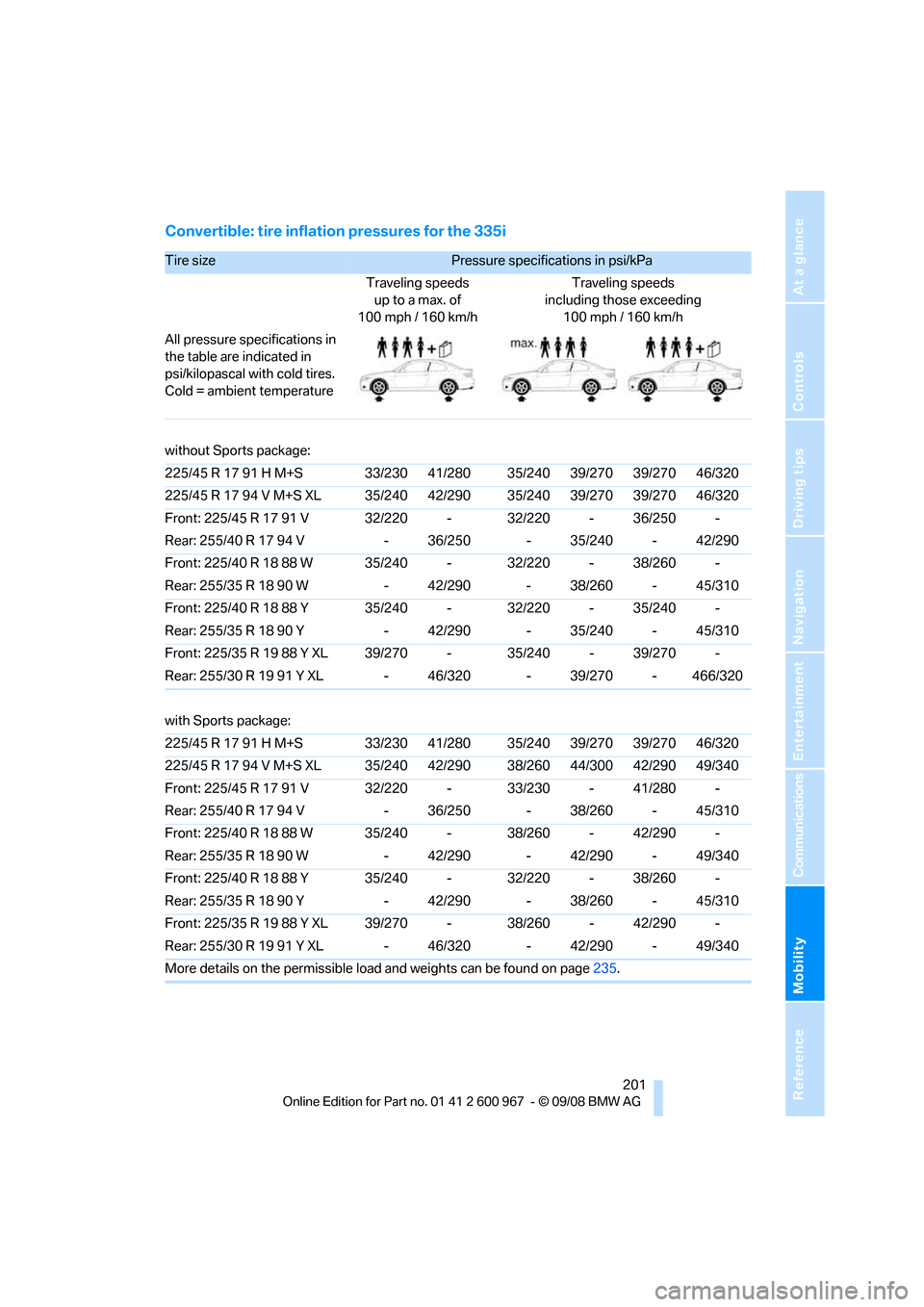
Mobility
201Reference
At a glance
Controls
Driving tips
Communications
Navigation
Entertainment
Convertible: tire inflation pressures for the 335i
Tire size Pressure specifications in psi/kPa
Traveling speeds
up to a max. of
100 mph / 160 km/hTraveling speeds
including those exceeding
100 mph / 160 km/h
All pressure specifications in
the table are indicated in
psi/kilopascal with cold tires.
Cold = ambient temperature
without Sports package:
225/45 R 17 91 H M+S 33/230 41/280 35/240 39/270 39/270 46/320
225/45 R 17 94 V M+S XL 35/240 42/290 35/240 39/270 39/270 46/320
Front: 225/45 R 17 91 V 32/220 - 32/220 - 36/250 -
Rear: 255/40 R 17 94 V - 36/250 - 35/240 - 42/290
Front: 225/40 R 18 88 W 35/240 - 32/220 - 38/260 -
Rear: 255/35 R 18 90 W - 42/290 - 38/260 - 45/310
Front: 225/40 R 18 88 Y 35/240 - 32/220 - 35/240 -
Rear: 255/35 R 18 90 Y - 42/290 - 35/240 - 45/310
Front: 225/35 R 19 88 Y XL 39/270 - 35/240 - 39/270 -
Rear: 255/30 R 19 91 Y XL - 46/320 - 39/270 - 466/320
with Sports package:
225/45 R 17 91 H M+S 33/230 41/280 35/240 39/270 39/270 46/320
225/45 R 17 94 V M+S XL 35/240 42/290 38/260 44/300 42/290 49/340
Front: 225/45 R 17 91 V 32/220 - 33/230 - 41/280 -
Rear: 255/40 R 17 94 V - 36/250 - 38/260 - 45/310
Front: 225/40 R 18 88 W 35/240 - 38/260 - 42/290 -
Rear: 255/35 R 18 90 W - 42/290 - 42/290 - 49/340
Front: 225/40 R 18 88 Y 35/240 - 32/220 - 38/260 -
Rear: 255/35 R 18 90 Y - 42/290 - 38/260 - 45/310
Front: 225/35 R 19 88 Y XL 39/270 - 38/260 - 42/290 -
Rear: 255/30 R 19 91 Y XL - 46/320 - 42/290 - 49/340
More details on the permissible load and weights can be found on page235.
Page 209 of 260
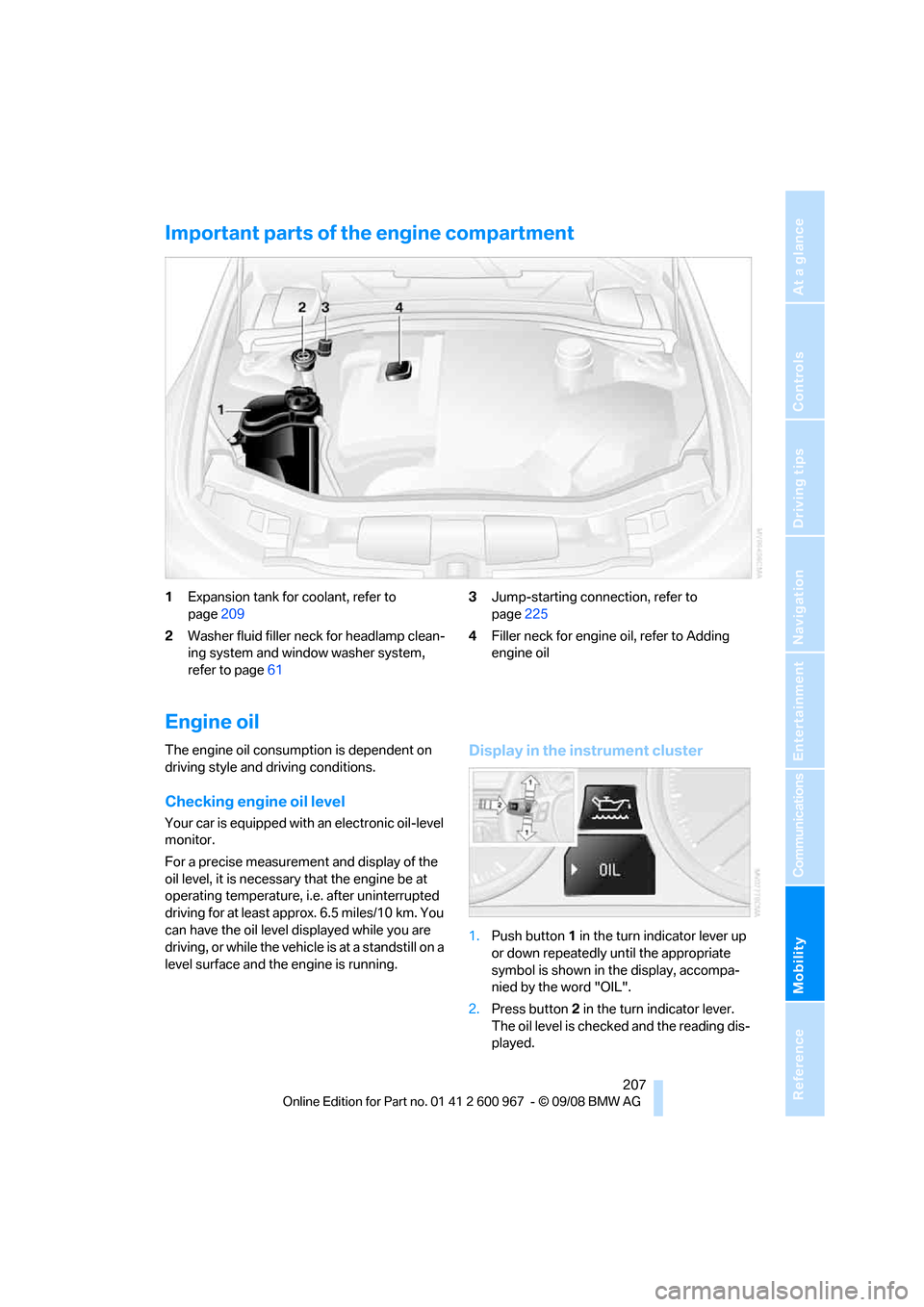
Mobility
207Reference
At a glance
Controls
Driving tips
Communications
Navigation
Entertainment
Important parts of the engine compartment
1Expansion tank for coolant, refer to
page209
2Washer fluid filler neck for headlamp clean-
ing system and window washer system,
refer to page613Jump-starting connection, refer to
page225
4Filler neck for engine oil, refer to Adding
engine oil
Engine oil
The engine oil consumption is dependent on
driving style and driving conditions.
Checking engine oil level
Your car is equipped with an electronic oil-level
monitor.
For a precise measurement and display of the
oil level, it is necessary that the engine be at
operating temperature, i.e. after uninterrupted
driving for at least approx. 6.5 miles/10 km. You
can have the oil level displayed while you are
driving, or while the vehicle is at a standstill on a
level surface and the engine is running.
Display in the instrument cluster
1.Push button 1 in the turn indicator lever up
or down repeatedly until the appropriate
symbol is shown in the display, accompa-
nied by the word "OIL".
2.Press button 2 in the turn indicator lever.
The oil level is checked and the reading dis-
played.
Page 223 of 260
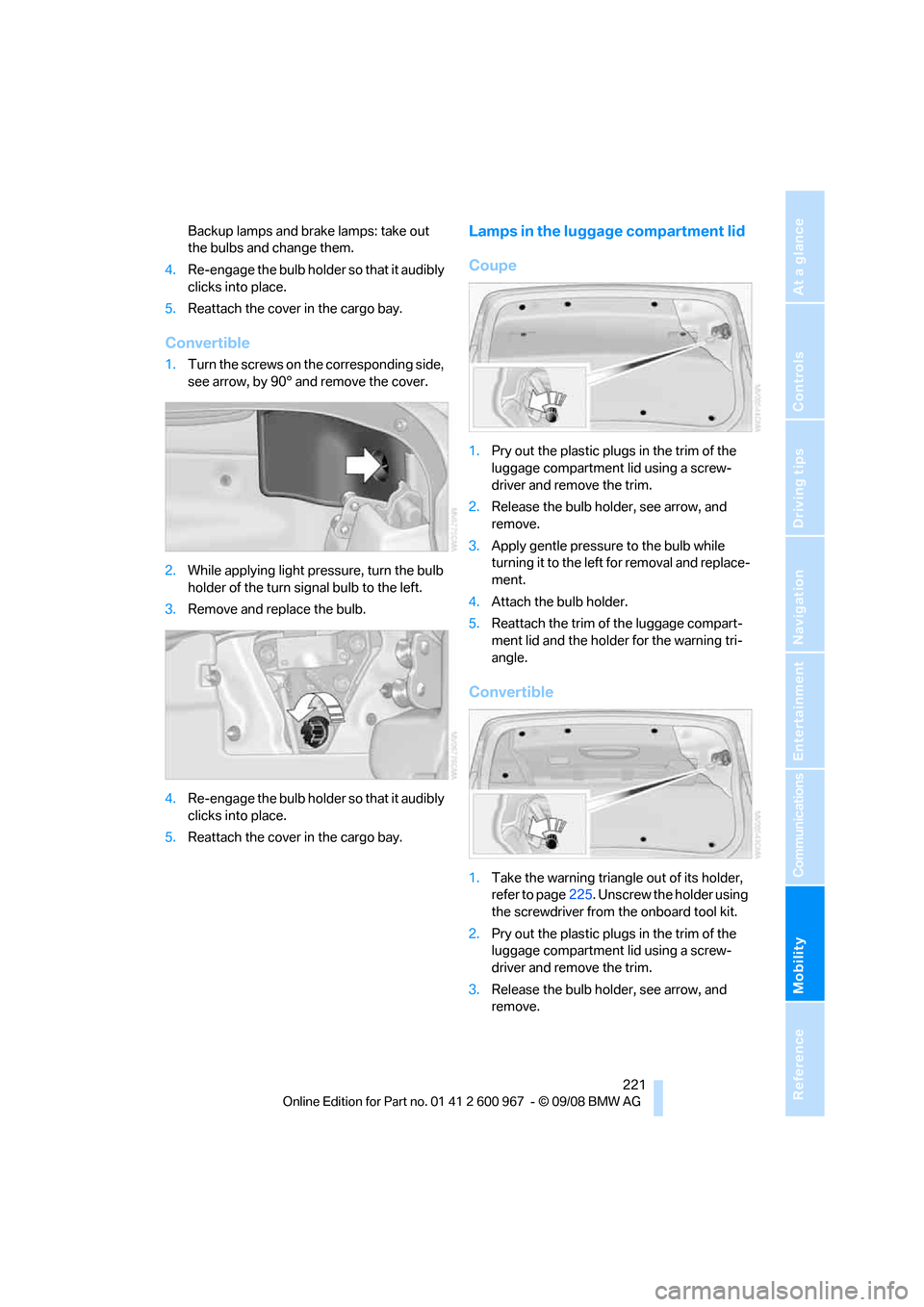
Mobility
221Reference
At a glance
Controls
Driving tips
Communications
Navigation
Entertainment
Backup lamps and brake lamps: take out
the bulbs and change them.
4.Re-engage the bulb holder so that it audibly
clicks into place.
5.Reattach the cover in the cargo bay.
Convertible
1.Turn the screws on the corresponding side,
see arrow, by 90° and remove the cover.
2.While applying light pressure, turn the bulb
holder of the turn signal bulb to the left.
3.Remove and replace the bulb.
4.Re-engage the bulb holder so that it audibly
clicks into place.
5.Reattach the cover in the cargo bay.
Lamps in the luggage compartment lid
Coupe
1.Pry out the plastic plugs in the trim of the
luggage compartment lid using a screw-
driver and remove the trim.
2.Release the bulb holder, see arrow, and
remove.
3.Apply gentle pressure to the bulb while
turning it to the left for removal and replace-
ment.
4.Attach the bulb holder.
5.Reattach the trim of the luggage compart-
ment lid and the holder for the warning tri-
angle.
Convertible
1.Take the warning triangle out of its holder,
refer to page225. Unscrew the holder using
the screwdriver from the onboard tool kit.
2.Pry out the plastic plugs in the trim of the
luggage compartment lid using a screw-
driver and remove the trim.
3.Release the bulb holder, see arrow, and
remove.
Page 224 of 260
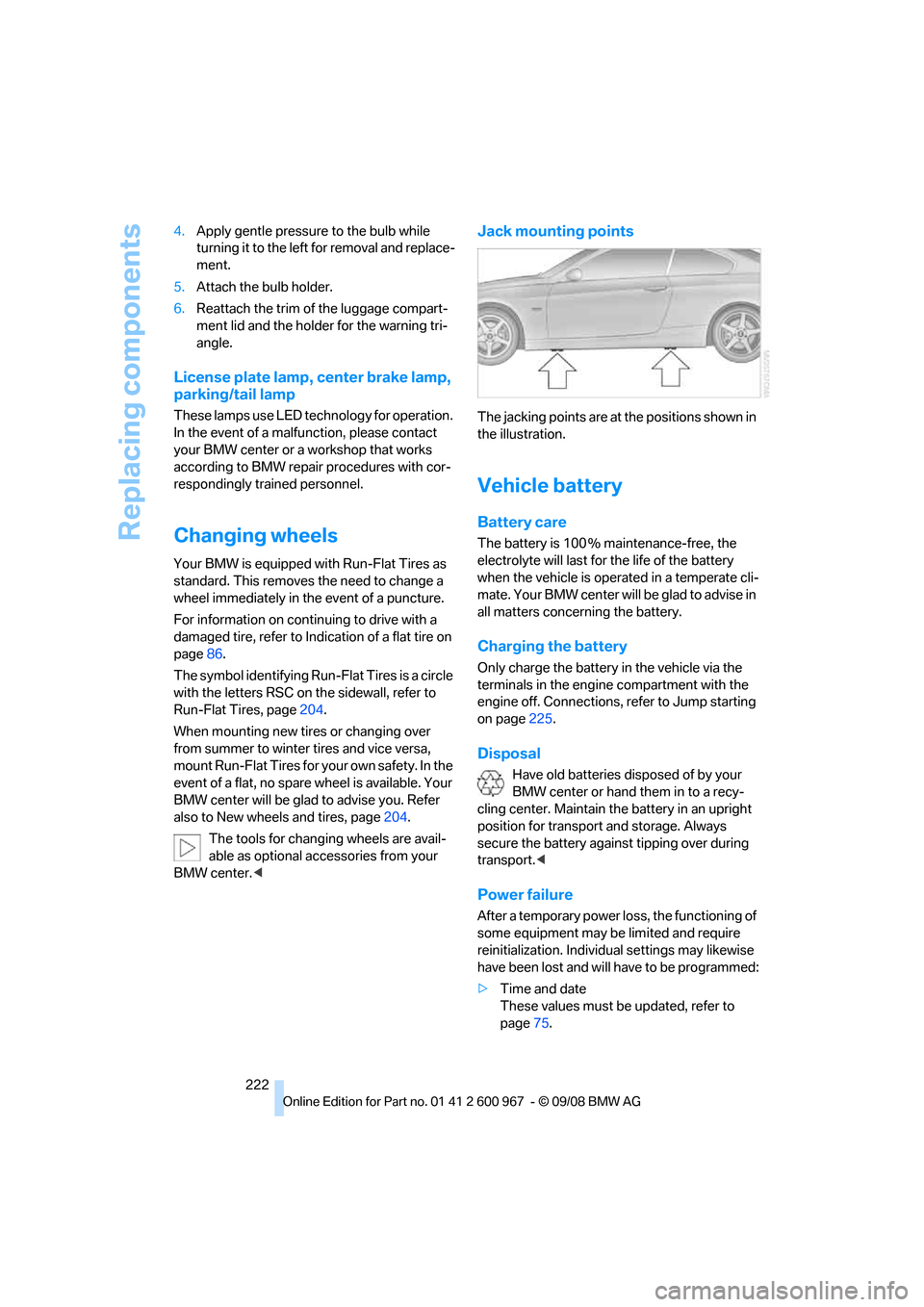
Replacing components
222 4.Apply gentle pressure to the bulb while
turning it to the left for removal and replace-
ment.
5.Attach the bulb holder.
6.Reattach the trim of the luggage compart-
ment lid and the holder for the warning tri-
angle.
License plate lamp, center brake lamp,
parking/tail lamp
These lamps use LED technology for operation.
In the event of a malfunction, please contact
your BMW center or a workshop that works
according to BMW repair procedures with cor-
respondingly trained personnel.
Changing wheels
Your BMW is equipped with Run-Flat Tires as
standard. This removes the need to change a
wheel immediately in the event of a puncture.
For information on continuing to drive with a
damaged tire, refer to Indication of a flat tire on
page86.
The symbol identifying Run-Flat Tires is a circle
with the letters RSC on the sidewall, refer to
Run-Flat Tires, page204.
When mounting new tires or changing over
from summer to winter tires and vice versa,
mount Run-Flat Tires for your own safety. In the
event of a flat, no spare wheel is available. Your
BMW center will be glad to advise you. Refer
also to New wheels and tires, page204.
The tools for changing wheels are avail-
able as optional accessories from your
BMW center.<
Jack mounting points
The jacking points are at the positions shown in
the illustration.
Vehicle battery
Battery care
The battery is 100 % maintenance-free, the
electrolyte will last for the life of the battery
when the vehicle is operated in a temperate cli-
mate. Your BMW center will be glad to advise in
all matters concerning the battery.
Charging the battery
Only charge the battery in the vehicle via the
terminals in the engine compartment with the
engine off. Connections, refer to Jump starting
on page225.
Disposal
Have old batteries disposed of by your
BMW center or hand them in to a recy-
cling center. Maintain the battery in an upright
position for transport and storage. Always
secure the battery against tipping over during
transport.<
Power failure
After a temporary power loss, the functioning of
some equipment may be limited and require
reinitialization. Individual settings may likewise
have been lost and will have to be programmed:
>Time and date
These values must be updated, refer to
page75.
Page 230 of 260
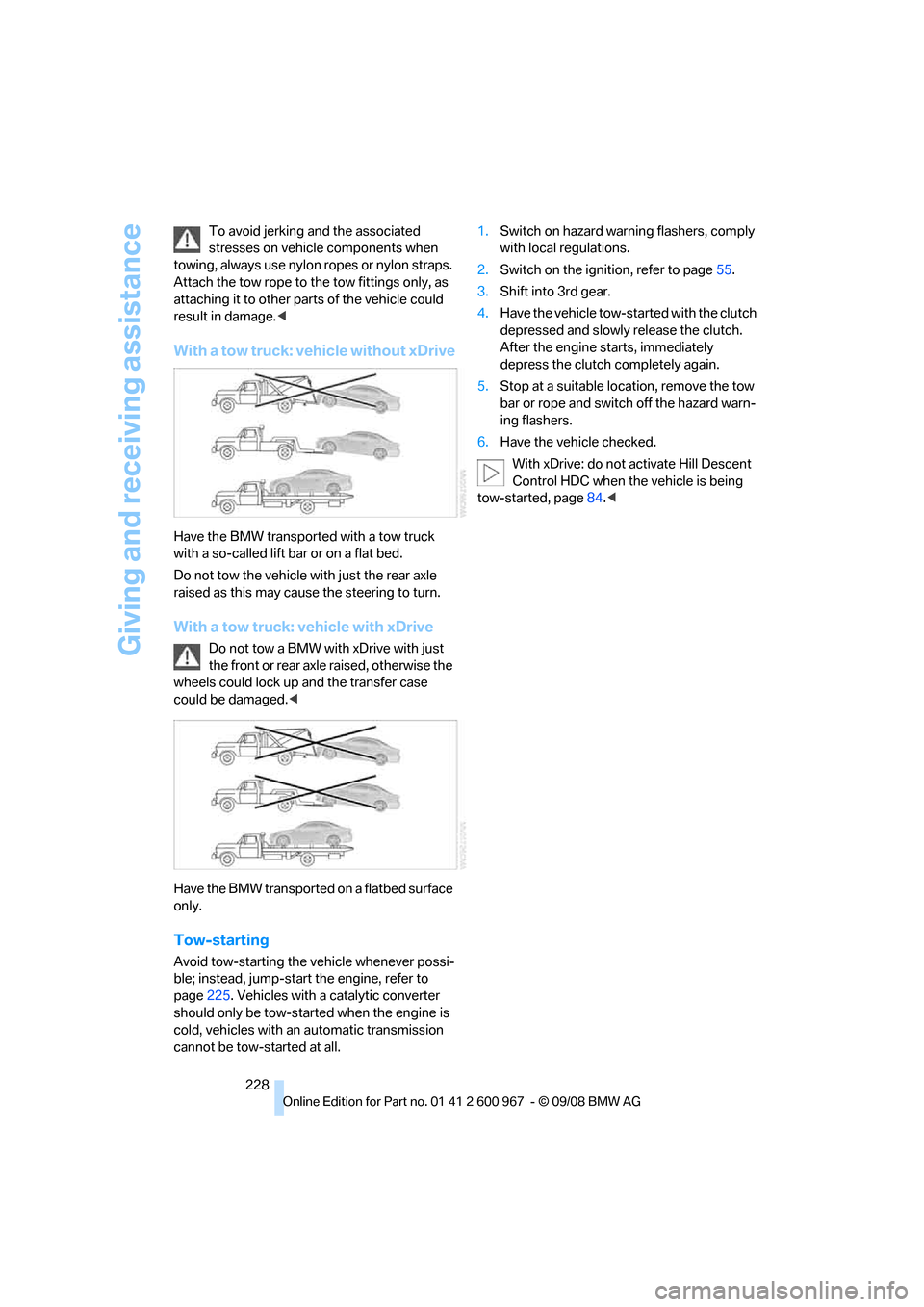
Giving and receiving assistance
228 To avoid jerking and the associated
stresses on vehicle components when
towing, always use nylon ropes or nylon straps.
Attach the tow rope to the tow fittings only, as
attaching it to other parts of the vehicle could
result in damage.<
With a tow truck: vehicle without xDrive
Have the BMW transported with a tow truck
with a so-called lift bar or on a flat bed.
Do not tow the vehicle with just the rear axle
raised as this may cause the steering to turn.
With a tow truck: vehicle with xDrive
Do not tow a BMW with xDrive with just
the front or rear axle raised, otherwise the
wheels could lock up and the transfer case
could be damaged.<
Have the BMW transported on a flatbed surface
only.
Tow-starting
Avoid tow-starting the vehicle whenever possi-
ble; instead, jump-start the engine, refer to
page225. Vehicles with a catalytic converter
should only be tow-started when the engine is
cold, vehicles with an automatic transmission
cannot be tow-started at all.1.Switch on hazard warning flashers, comply
with local regulations.
2.Switch on the ignition, refer to page55.
3.Shift into 3rd gear.
4.Have the vehicle tow-started with the clutch
depressed and slowly release the clutch.
After the engine starts, immediately
depress the clutch completely again.
5.Stop at a suitable location, remove the tow
bar or rope and switch off the hazard warn-
ing flashers.
6.Have the vehicle checked.
With xDrive: do not activate Hill Descent
Control HDC when the vehicle is being
tow-started, page84.<